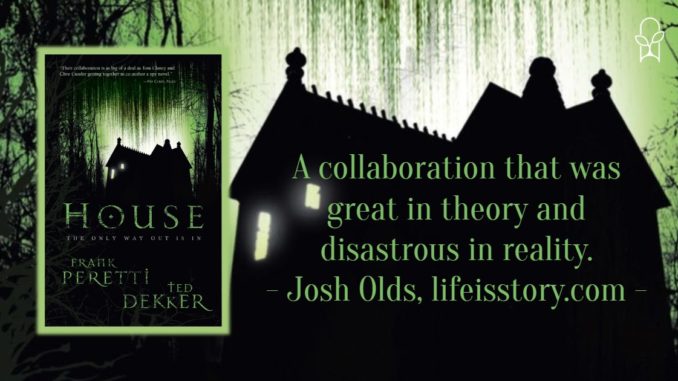
Also by this author: The Promise, The Drummer Boy, Sinner, Green, The Dream Traveler's Quest, Into the Book of Light, The Curse of Shadownman, The Garden and the Serpent, The Final Judgment, Millie Maven and the Bronze Medallion
Published by Thomas Nelson on March 13, 2006
Genres: Fiction, Christian, Horror
Buy on Amazon
Goodreads

A mind-bending supernatural thriller from the creators of This Present Darkness and Saint.
Frank Peretti and Ted Dekker—two of the most acclaimed writers of supernatural thrillers—have joined forces for the first time to craft a story unlike any you've ever read. Enter House—where you'll find yourself thrown into a killer's deadly game in which the only way to win is to lose . . . and the only way out is in.
The stakes of the game become clear when a tin can is tossed into the house with rules scrawled on it. Rules that only a madman—or worse—could have written. Rules that make no sense yet must be followed.
One game. Seven players. Three rules. Game ends at dawn.
It was a collaboration between the established trailblazer nearing the end of his career and the young, idealistic upstart whose recent work followed in his footsteps. Theoretically, it was a no-brainer: put the top two Christian supernatural horror writers together and let them work their magic. But in reality, the story of House’s journey to print is almost as much of a disaster as the book is itself.
Frank Peretti was the established star, having basically invented Christian supernatural horror in the mid-1980s with This Present Darkness. In that novel, Peretti took a rather anthropomorphic and medieval view of demons, analogizing supernatural warfare as something that looks pretty close to actual warfare, and contributing to the “Satanic Panic” of the 1980s. It was a blockbuster at the time, but has aged horribly—thematically and theologically—and isn’t well written at all. Peretti’s writing would improve, but his overwrought and overwritten portrayals of the demonic would continue to be a core element of his writing. In 2006, Peretti’s career was coming to an end. Dealing with declining books sales (and declining health), House was an attempt to revitalize Peretti’s career by attaching his name to a new, rising star.
Ted Dekker was the up-and-coming star of the Christian Bookseller’s Association. He’d won his first Christy Award for his novel Thr3e (2003), then released a suspense fantasy trilogy retelling redemptive history (The Circle Trilogy, 2004) that really launched his career into the stratosphere. While Dekker’s novels had started out more in line with typical Christian fiction of the day, his popularity had allowed him to pull an old novel out of his drawer called Showdown (2005)—and that’s when the comparison to Peretti began. However the collaboration came about, it seemed like a perfect match. Each author brought something to the table the other needed.
Unfortunately, the result was this novel. The core of the story is serviceable. The titular house is a representation of the human soul dealing with its sins and flaws. It’s a purgatory of sorts, though the Protestant authors would never say as much. Dekker and Peretti, in an attempt to create an aura of mystery, spend most of the book without explaining that theme, playing the story up as straight horror. It’s in holding their cards too close to their chest that they miss out. The driving force of the story is never obvious. The spiritual theme is supposed to be a twist, but House lacks the appropriate foreshadowing to make the twist work. Instead, the story’s Jesus character is left to explain everything as exposition near the end.
“We’ve been fighting our own hearts?”
“No,” Susan said. “The evil in your hearts.”
“The ultimate haunted house,” Jack said.
So, yes—spoilers, I guess—the whole story is a metaphor for four people coming to terms with the evil in their hearts and their need for salvation. The problem is that, without the authors almost breaking the fourth wall to say that directly you’d never know that. There’s a lot that goes on in the story, it’s clear something supernatural is afoot, but is it a serial killer story about Barsidious White/The Tin Man? Is it about demons named Betty, Stewart, and Pete personifying elements of past sin? It’s almost like there are two stories going—two stories by two different authors.
And there’s good reason for that. Peretti and Dekker never seem to well establish their story. For those familiar with their work, you can see which elements are Dekker’s and which are Peretti’s, but almost nothing seems theirs. Erin Healy, their editor for this book, was left to cobble together two very different vision into a completed manuscript and it’s a testament to her skill that the book reads as well as it does. The divisions were so sharp that Peretti’s vision for the story’s conclusion, while Dekker’s ending was used in the (equally bad for different reasons) feature film.
Dekker was in the middle of what has now become called The Books of History Chronicles. During that time period 2004-2010ish, nearly every book had some connection to the shared universe of the Circle Trilogy. Dekker wanted the villain, Barsidious White, to play a larger role—and wanted White connected to the villains Marsuvees Black (from Showdown) and Sterling Red (from Skin). (And see how these three villains would be named Black, Red, and White, mimicking the titles of The Circle Trilogy?) Peretti wanted to focus on the demonic angle.
In the end, the story reads more like a Peretti novel, but, then again, I’m probably biased because I have a less favorable view of Peretti. Suffice it to say that this story didn’t work for either author. Peretti’s career nearly ended after it. Dekker’s career continued to soar, but it marked the end (so far) of any interest in turning his books into films.
If you want to see what Dekker’s version of the book would have been, you don’t have to look any further than Skin, also released in 2006. The parallels are astounding: Four disagreeable individuals who argue a lot are trapped in a supernatural location while being pursued by a serial killer and the whole thing ends up being a metaphor for addressing past sin/trauma. Both books even start with one of the protagonists getting into a car wreck. Not that Skin ends up being much better, but it is at least Dekker’s vision, which is superior to Peretti’s.
Looking at the endorsement pages on the inside of the book—where you’d expect some other top names in Christian fiction or well-known reviewing organizations would be featured—you instead see a random newspaper in West Virginia, a Blogspot blog with 100 followers, and a couple other random websites. That’s a pretty good sign right there. They couldn’t find any big-name publication or author to lend an endorsement. Even the endorsement on the cover avoids mentioning the book, only saying that Dekker and Peretti’s “collaboration is as big of a deal as Tom Clancy and Clive Cussler getting together.” I feel like, from the beginning, everybody involved knew this story just didn’t work and it got put out there anything, because, hey, that’s business, baby.

